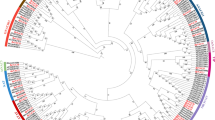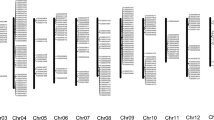Abstract
Brassica rapa L. (AA, 2n = 20), an A genome diploid species of Brassica genus is of researchers interest recent days since enormous amount of data is available about the genome. Since EST analysis is a powerful tool in gene discovery we compared different existing methods and developed a new pipeline for EST computational analysis to analyze the available data. A total of 1,438 expressed sequence tags sizing from 83 to 2,023 base pairs were generated and subjected to various types of analysis. Cluster analysis of these ESTs identified 969 unique sequences called unigenes, with 162 contigs and 807 singlets. Similarity search produced 704 significant hits with E-value ≥ 10−5. The functions of the best hits were annotated by gene ontology (GO) analysis. Additionally, we classified 293 and 541 unigenes based on their functions, using Kyoto Encyclopedia of Genes and Genomes (KEGG) pathways and protein structural domain databases, respectively. We also identified and categorized 171 microsatellites into di-, tri-, tetra-, and penta nucleotide repeats, and designed primers. Possible open reading frames (ORFs) were predicted for 960 unigenes, by the comparison with a primary protein sequence database. In silico mapping of partial unigenes were done in bacterial artificial chromosome (BAC) sequences, downloaded from the Brassica genome project website. We determined 149 single nucleotide polymorphisms (SNPs) and 3 indels from the coding region of 27 unigenes of B. rapa and similar Brassica napus ESTs clusters. All the generated EST sequences were submitted to the GenBank EST database (dbEST) as accessions from CO749247 to CO750425.
Graphical abstract

Similar content being viewed by others
References
Adams, MD, Kelley JM, Gocayne JD, Dubnick M, Polymeropoulos MH, Xiao H, Merril CR, Wu A, Olde B, Moreno RF, et al. (1991) Complementary DNA sequencing: expressed sequence tags and human genome project. Science 252: 1651–6.
Ana C and Stefan G (2008) Blast2GO: A comprehensive suite for functional analysis in plant genomics. Int. J. Plant Genomics 2008: 619832.
Bell E and Mullet JE (1993) Characterization of an Arabidopsis lipoxygenase gene responsive to methyl jasmonate and wounding. Plant Physiol. 103: 1133–1137.
Christiam C, George C, Vahram A, Ning M, Jason P, Kevin B and Thomas LM (2009) BLAST+: architecture and applications. BMC Bioinfor. 10: 421.
Evgeni MZ and Rolf A (2001) InterProScan-an integration platform for the signature-recognition methods in InterPro. Bioinformatics 17: 847–848.
Fahey JW and Talalay P (1995) The role of crucifers in cancer chemoprotection. In: Gustin DL, Flores, H.E., (ed) Phytochemicals and health. Am. Soc. Pl. Physiol. 87–93.
Feng L, Ingeborg H, Geo P, Svetlana K, Steven LS and John Q (2000) An optimized protocol for analysis of EST sequences. Nucl. Acids Res. 28: 3657–3665.
Götz S, Juan M, Gómez G, Terol J, Williams TD, Nagaraj SH, Nueda MJ, Robles M, Talón M, Dopazo J, et al. (2008) High-throughput functional annotation and data mining with the Blast2GO suite. Nucl. Acids Res. 36: 3420–3435.
Huang X and Madan A (1999) CAP3: A DNA sequence assembly program. Genome Res. 9: 868–877.
James KW (2002) BLAT-the BLAST-like alignment tool. Genome Res. 12: 656–664.
Juan F, Antonio L, Noe FP, Francisco C, Guillermo PT and Gonzalo CM (2010) SeqTrim: a high-throughput pipeline for pre-processing any type of sequence read. BMC Bioinfor. 11: 38.
Khan MS, Haas FH, Samami AA, Gholami AM, Bauer A, Fellenberg K, Reichelt M, Hänsch R, Mendel RR, Meyer AJ, et al. (2010) Sulfite reductase defines a newly discovered bottleneck for assimilatory sulfate reduction and is essential for growth and development in Arabidopsis thaliana. Plant Cell 22: 1216–1231.
Kim HY, Choi SR, Bae J, Hong CP, Lee SY, Hossain MJ, Nguyen DV, Jin M, Park BS, Bang JW, et al.(2009) Sequenced BAC anchored reference genetic map that reconciles the ten individual chromosomes of B. rapa. BMC Genomics 10: 432.
Kozik A, Chan B and Michelmore R (2007) Python DIS pipeline. UCDavis. http://cgpdb.ucdavis.edu/SNP_Discovery. Accessed 20 February 2011.
Min XJ, Butler G, Storms R and Tsang A (2005) OrfPredictor: predicting protein-coding regions in EST-derived sequences. Nucl. Acids Res. (Web Server Issue): W677–W680.
Morgante M, Hanafey M and Powell W (2002) Microsatellites are preferentially associated with nonrepetitive DNA in plant genomes. Nat. Genet. 30: 194–200.
Mou Z, He Y, Dai Y, Liu X and Li J (2000) Deficiency in fatty acid synthase leads to premature cell death and dramatic alterations in plant morphology. Plant Cell 12: 405–418.
Nagaharu U (1935) Genome analysis in Brassica with special reference to the experimental formation of B. napus and peculiar mode of fertilization. JPN. J. Bot. 7: 389–452.
Olof E, Soren B, Gunna, VH and Henrik N (2007) Locating proteins in the cell using TargetP, SignalP, and related tools. Nat. Protoc. 2: 953–971.
Park JY, Koo DH, Hong CP, Lee SJ, Jeon JW, Lee SH, Yun PY, Park BS, Kim HR, Bang JW, et al. (2005) Physical mapping and microsynteny of B. rapa ssp. pekinensis genome corresponding to a 222 kbp gene-rich region of Arabidopsis chromosome 4 and partially duplicated on chromosome 5. Mol. Genet. Genomics 274: 579–588.
Roy A, Kucukural A and Zhang Y (2010) I-TASSER: a unified platform for automated protein structure and function prediction. Nat. Protoc. 5: 725–738.
Rozen S and Skaletsky H (2000) Primer3 on the www for general users and for biologist programmers. Methods Mol. Biol. 132: 365–386.
Smit AFA, Hubley R and Green P (2010) RepeatMasker Open-3.0. http://www.repeatmasker.org. Accessed 30 January 2011.
Strawn MA, Marr SK, Inoue K, Inada N, Zubieta C and Wildermuth MC (2007) Arabidopsis isochorismate synthase functional in pathogen-induced salicylate biosynthesis exhibits properties consistent with a role in diverse stress responses. J. Biol. Chem. 282: 5919–5933.
Theodoulou FL (2000) Plant ABC transporters. Biochim. Biophys. Acta 1465: 79–103.
Yang Z and Jeffrey S (2004) Scoring function for automated assessment of protein structure template quality. Proteins 57: 702–710.
Author information
Authors and Affiliations
Corresponding author
Electronic supplementary material
Electronic supplementary material
Rights and permissions
About this article
Cite this article
Dhandapani, V., Choi, S.R., Paul, P. et al. Development of EST database and transcriptome analysis in the leaves of Brassica rapa using a newly developed pipeline. Genes Genom 34, 671–679 (2012). https://doi.org/10.1007/s13258-012-0015-y
Received:
Accepted:
Published:
Issue Date:
DOI: https://doi.org/10.1007/s13258-012-0015-y




